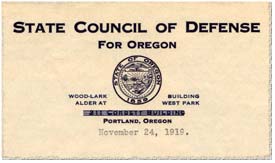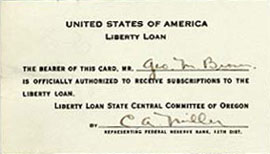A Busy Agenda
Page Content
 The council used this letterhead when corresponding on subjects from patriotism to controlling the state's economy. (OSA, Oregon Defense Council Records, State Historian's Correspondence, Box 1, Folder 17)
The council used this letterhead when corresponding on subjects from patriotism to controlling the state's economy. (OSA, Oregon Defense Council Records, State Historian's Correspondence, Box 1, Folder 17)
State Council of Defense for Oregon
Defining the Purpose
The State Council of Defense for Oregon shared similarities with councils from other states in its main purposes for creation:
- Cooperate with the federal government to organize and direct human, industrial, and material resources efficiently and effectively to win the war.
-
Promote a patriotic spirit and educate Oregonians about the magnitude of the war effort.
Aid in recruiting for the Army and Navy, including the military draft.
-
Encourage increased production and decreased use of food and materials vital to the war effort.
Endless Organizing
The council began the task of organizing Oregon for war soon after Governor Withycombe authorized it in May 1917. It helped form defense councils in all 36 Oregon counties by early summer, making possible the coordination of war activities that were to follow. At the recommendation of the Council of National Defense, it pushed further to organize the creation of community councils. These councils formed in school districts and voting precincts across the state and worked under the coordination of county defense councils to further the goals of the state council.
Beginning to Make a Difference

Fund drive workers carried authorization cards to lessen the opportunities for illegal solicitation. (OSA, Oregon Defense Council Records, Publications and Ephemera, Box 8, Folder 1).
View list of authorized charities. (PDF)
Many of the council's activities are described in the section of this exhibit on the home front. Here are a few examples of its wide ranging activities and connections:
- The council convened 74 meetings as part of a patriotic campaign that brought "the message of the trenches" to nearly 100,000 Oregonians around the state. Three experienced British officers lectured to citizens who, for the most part, had not heard such stirring first hand accounts from the front lines of battle.
- The council strictly controlled the solicitation of funds in Oregon. Only charities and drives approved by the council's coordination committee could legally solicit money. This was one way to limit the inevitable "flim flam" men who would attempt to collect money for phony charities, even while the country was at war. While the list of approved charities changed over time, mainstays included the Red Cross and United War Work Campaign. The council also assumed control of how money from various Oregon war collections would be apportioned or shared among counties.
- The council coordinated activities with a impressive array of federal, state, and local governments; civic, religious, and cultural associations; and numerous other organizations. Major groups included the Young Men's Christian Association, the Young Women's Christian Association, Knights of Columbus, and the Salvation Army. But the council worked with other entities as well. Some associated women's groups included:
Collegiate Alumnae
Congress of Mothers
Consumer's League
Council of Jewish Women
Daughters of the American Revolution
Daughters of the Confederacy
Eastern Star
Equal Suffrage Association
Federation of Catholic Alumnae
Federation of Musical Clubs
Federation of Women's Clubs
Ladies Mutual Improvement Association
Oregon Home Missionary Society
Pythian Sisters
Rebekahs
Women of Woodcraft
Women's Christian Temperance Union
Women's Relief Corps